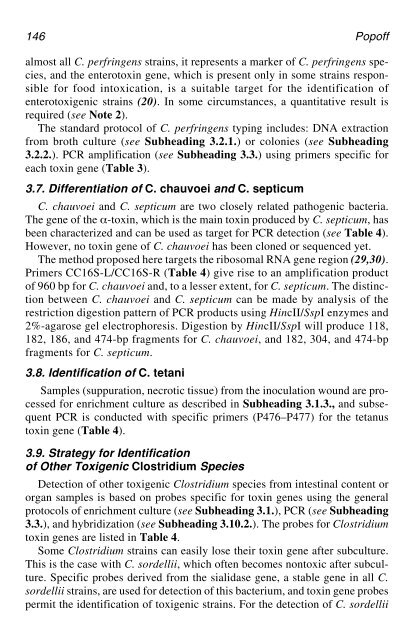PCR Detection of Microbial Pathogens PCR Detection of Microbial ...
PCR Detection of Microbial Pathogens PCR Detection of Microbial ...
PCR Detection of Microbial Pathogens PCR Detection of Microbial ...
Create successful ePaper yourself
Turn your PDF publications into a flip-book with our unique Google optimized e-Paper software.
146 Pop<strong>of</strong>f<br />
almost all C. perfringens strains, it represents a marker <strong>of</strong> C. perfringens species,<br />
and the enterotoxin gene, which is present only in some strains responsible<br />
for food intoxication, is a suitable target for the identification <strong>of</strong><br />
enterotoxigenic strains (20). In some circumstances, a quantitative result is<br />
required (see Note 2).<br />
The standard protocol <strong>of</strong> C. perfringens typing includes: DNA extraction<br />
from broth culture (see Subheading 3.2.1.) or colonies (see Subheading<br />
3.2.2.). <strong>PCR</strong> amplification (see Subheading 3.3.) using primers specific for<br />
each toxin gene (Table 3).<br />
3.7. Differentiation <strong>of</strong> C. chauvoei and C. septicum<br />
C. chauvoei and C. septicum are two closely related pathogenic bacteria.<br />
The gene <strong>of</strong> the α-toxin, which is the main toxin produced by C. septicum, has<br />
been characterized and can be used as target for <strong>PCR</strong> detection (see Table 4).<br />
However, no toxin gene <strong>of</strong> C. chauvoei has been cloned or sequenced yet.<br />
The method proposed here targets the ribosomal RNA gene region (29,30).<br />
Primers CC16S-L/CC16S-R (Table 4) give rise to an amplification product<br />
<strong>of</strong> 960 bp for C. chauvoei and, to a lesser extent, for C. septicum. The distinction<br />
between C. chauvoei and C. septicum can be made by analysis <strong>of</strong> the<br />
restriction digestion pattern <strong>of</strong> <strong>PCR</strong> products using HincII/SspI enzymes and<br />
2%-agarose gel electrophoresis. Digestion by HincII/SspI will produce 118,<br />
182, 186, and 474-bp fragments for C. chauvoei, and 182, 304, and 474-bp<br />
fragments for C. septicum.<br />
3.8. Identification <strong>of</strong> C. tetani<br />
Samples (suppuration, necrotic tissue) from the inoculation wound are processed<br />
for enrichment culture as described in Subheading 3.1.3., and subsequent<br />
<strong>PCR</strong> is conducted with specific primers (P476–P477) for the tetanus<br />
toxin gene (Table 4).<br />
3.9. Strategy for Identification<br />
<strong>of</strong> Other Toxigenic Clostridium Species<br />
<strong>Detection</strong> <strong>of</strong> other toxigenic Clostridium species from intestinal content or<br />
organ samples is based on probes specific for toxin genes using the general<br />
protocols <strong>of</strong> enrichment culture (see Subheading 3.1.), <strong>PCR</strong> (see Subheading<br />
3.3.), and hybridization (see Subheading 3.10.2.). The probes for Clostridium<br />
toxin genes are listed in Table 4.<br />
Some Clostridium strains can easily lose their toxin gene after subculture.<br />
This is the case with C. sordellii, which <strong>of</strong>ten becomes nontoxic after subculture.<br />
Specific probes derived from the sialidase gene, a stable gene in all C.<br />
sordellii strains, are used for detection <strong>of</strong> this bacterium, and toxin gene probes<br />
permit the identification <strong>of</strong> toxigenic strains. For the detection <strong>of</strong> C. sordellii






